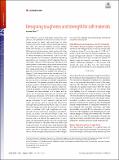| dc.contributor.author | Zhao, Xuanhe | |
| dc.date.accessioned | 2018-04-17T15:33:34Z | |
| dc.date.available | 2018-04-17T15:33:34Z | |
| dc.date.issued | 2017-07 | |
| dc.identifier.issn | 0027-8424 | |
| dc.identifier.issn | 1091-6490 | |
| dc.identifier.uri | http://hdl.handle.net/1721.1/114757 | |
| dc.description.abstract | Soft materials, such as hydrogels, elastomers, and plastics, are pervasive in nature and society. For example, except for teeth, nails, and bones, all other components of the human body are hydrogels, and we eat, wear, and use soft materials as foods, clothes, shoes, and car tires, just to name a few, in our daily life. Although amorphous polymer chains endow soft materials with high flexibility or “softness,” they can also lead to inferior mechanical performances, such as low fracture toughness and low strength, frequently hampering applications and innovations of soft materials. Over recent years, intensive efforts have been devoted to the development of soft materials that possess extraordinary mechanical properties, especially by seeking inspiration from nature and biology. For instance, synthetic hydrogels can now be made much tougher than articular cartilages and more adhesive than mussel glues. In PNAS, Wu et al. report the fabrication of bioinspired fibers with both high toughness and high strength by drawing from a hydrogel at ambient temperatures and pressures. This nascent progress in the field raises a generic question. What are the fundamental principles for the design of soft materials to achieve certain mechanical properties in nature and engineered systems? Compared with hard materials such as steels and ceramics, which have been explored over centuries, such principles are still elusive in the field of soft materials. | en_US |
| dc.description.sponsorship | National Science Foundation (U.S.) (Grant CMMI-1661627) | en_US |
| dc.description.sponsorship | United States. Office of Naval Research (Grant N00014-14-1-0619) | en_US |
| dc.description.sponsorship | Massachusetts Institute of Technology. Institute for Soldier Nanotechnologies | en_US |
| dc.publisher | National Academy of Sciences (U.S.) | en_US |
| dc.relation.isversionof | http://dx.doi.org/10.1073/PNAS.1710942114 | en_US |
| dc.rights | Article is made available in accordance with the publisher's policy and may be subject to US copyright law. Please refer to the publisher's site for terms of use. | en_US |
| dc.source | National Academy of Sciences | en_US |
| dc.title | Designing toughness and strength for soft materials | en_US |
| dc.type | Article | en_US |
| dc.identifier.citation | Zhao, Xuanhe. “Designing Toughness and Strength for Soft Materials.” Proceedings of the National Academy of Sciences, vol. 114, no. 31, Aug. 2017, pp. 8138–40. © 2017 National Academy of Sciences | en_US |
| dc.contributor.department | Massachusetts Institute of Technology. Department of Mechanical Engineering | en_US |
| dc.contributor.mitauthor | Zhao, Xuanhe | |
| dc.relation.journal | Proceedings of the National Academy of Sciences | en_US |
| dc.eprint.version | Final published version | en_US |
| dc.type.uri | http://purl.org/eprint/type/JournalArticle | en_US |
| eprint.status | http://purl.org/eprint/status/PeerReviewed | en_US |
| dc.date.updated | 2018-04-13T19:17:21Z | |
| dspace.orderedauthors | Zhao, Xuanhe | en_US |
| dspace.embargo.terms | N | en_US |
| dc.identifier.orcid | https://orcid.org/0000-0001-5387-6186 | |
| mit.license | PUBLISHER_POLICY | en_US |
